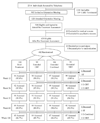Extended treatment of older cigarette smokers
- PMID: 19392908
- PMCID: PMC2718733
- DOI: 10.1111/j.1360-0443.2009.02548.x
Extended treatment of older cigarette smokers
Erratum in
- Addiction. 2011 Jun;106(6):1204
Abstract
Aims: Tobacco dependence treatments achieve abstinence rates of 25-30% at 1 year. Low rates may reflect failure to conceptualize tobacco dependence as a chronic disorder. The aims of the present study were to determine the efficacy of extended cognitive behavioral and pharmacological interventions in smokers > or = 50 years of age, and to determine if gender differences in efficacy existed.
Design: Open randomized clinical trial.
Setting: A free-standing, smoking treatment research clinic.
Participants: A total of 402 smokers of > or = 10 cigarettes per day, all 50 years of age or older.
Intervention: Participants completed a 12-week treatment that included group counseling, nicotine replacement therapy (NRT) and bupropion. Participants, independent of smoking status, were then assigned randomly to follow-up conditions: (i) standard treatment (ST; no further treatment); (ii) extended NRT (E-NRT; 40 weeks of nicotine gum availability); (iii) extended cognitive behavioral therapy (E-CBT; 11 cognitive behavioral sessions over a 40-week period); or (iv) E-CBT plus E-NRT (E-combined; 11 cognitive behavioral sessions plus 40 weeks nicotine gum availability).
Measurements: Primary outcome variable was 7-day point prevalence cigarette abstinence verified biochemically at weeks 24, 52, 64 and 104.
Findings: The most clinically important findings were significant main effects for treatment condition, time and the treatment x time interaction. The E-CBT condition produced high cigarette abstinence rates that were maintained throughout the 2-year study period [(week 24 (58%), 52 (55%), 64 (55%) and 104 (55%)], and was significantly more effective than E-NRT and ST across that period. No other treatment condition was significantly different to ST. No effects for gender were found.
Conclusions: Extended cognitive behavioral treatments can produce high and stable cigarette abstinence rates for both men and women. NRT does not add to the efficacy of extended CBT, and may hamper its efficacy. Research is needed to determine if these results can be replicated in a sample with a greater range of ages, and improved upon with the addition of medications other than NRT.
Trial registration: ClinicalTrials.gov NCT00086385.
Figures
References
-
- Surgeon General. Women and Smoking: A Report of the Surgeon General. Rockville, MD: US Government Printing Office; 2001.
-
- Fiore MC. Clinical practice guidelines for treating tobacco use and dependence: a US Public Health Service Report. JAMA. 2000;283:3244–3254. - PubMed
-
- Garvey AJ, Bliss RE, Hitchcock JL, Heinhold JW, Rosner B. Predictors of smoking relapse among self-quitters: a report from the normative aging study. Addict Behav. 1992;17:367–377. - PubMed
-
- Lichtenstein E, Weiss SM, Hitchcock JL, Leveton LB, O’Connell KA, Prochaska JO. Patterns of smoking relapse. Health Psychol. 1986;5 suppl:29–40. - PubMed
-
- Fiore MC. Treating Tobacco Use and Dependence: 2008 Update. Clinical Practice Guideline. Rockville, MD: US Department of Health and Human Services, Public Health Service Report; 2008.
Publication types
MeSH terms
Substances
Associated data
Grants and funding
LinkOut - more resources
Full Text Sources
Medical



